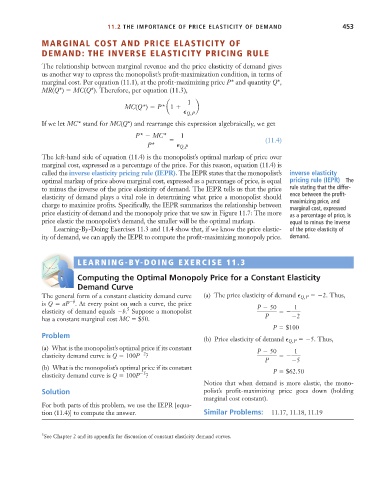Page 479 - Microeconomics, Fourth Edition
P. 479
c11monopolyandmonopsony.qxd 7/14/10 7:58 PM Page 453
11.2 THE IMPORTANCE OF PRICE ELASTICITY OF DEMAND 453
MARGINAL COST AND PRICE ELASTICITY OF
DEMAND: THE INVERSE ELASTICITY PRICING RULE
The relationship between marginal revenue and the price elasticity of demand gives
us another way to express the monopolist’s profit-maximization condition, in terms of
marginal cost. Per equation (11.1), at the profit-maximizing price P* and quantity Q*,
MR(Q*) MC(Q*). Therefore, per equation (11.3),
1
MC(Q *) P * a1 b
Q,P
If we let MC* stand for MC(Q*) and rearrange this expression algebraically, we get
P * MC* 1
(11.4)
P* Q, P
The left-hand side of equation (11.4) is the monopolist’s optimal markup of price over
marginal cost, expressed as a percentage of the price. For this reason, equation (11.4) is
called the inverse elasticity pricing rule (IEPR). The IEPR states that the monopolist’s inverse elasticity
optimal markup of price above marginal cost, expressed as a percentage of price, is equal pricing rule (IEPR) The
to minus the inverse of the price elasticity of demand. The IEPR tells us that the price rule stating that the differ-
elasticity of demand plays a vital role in determining what price a monopolist should ence between the profit-
charge to maximize profits. Specifically, the IEPR summarizes the relationship between maximizing price, and
marginal cost, expressed
price elasticity of demand and the monopoly price that we saw in Figure 11.7: The more as a percentage of price, is
price elastic the monopolist’s demand, the smaller will be the optimal markup. equal to minus the inverse
Learning-By-Doing Exercises 11.3 and 11.4 show that, if we know the price elastic- of the price elasticity of
ity of demand, we can apply the IEPR to compute the profit-maximizing monopoly price. demand.
LEARNING-BY-DOING EXERCISE 11.3
S
D
E
Computing the Optimal Monopoly Price for a Constant Elasticity
Demand Curve
The general form of a constant elasticity demand curve (a) The price elasticity of demand Q,P 2. Thus,
b
is Q aP . At every point on such a curve, the price
5
elasticity of demand equals b. Suppose a monopolist P 50 1
has a constant marginal cost MC $50. P 2
P $100
Problem
(b) Price elasticity of demand Q,P 5. Thus,
(a) What is the monopolist’s optimal price if its constant P 50 1
elasticity demand curve is Q 100P 2 ?
P 5
(b) What is the monopolist’s optimal price if its constant P $62.50
elasticity demand curve is Q 100P 5 ?
Notice that when demand is more elastic, the mono-
Solution polist’s profit-maximizing price goes down (holding
marginal cost constant).
For both parts of this problem, we use the IEPR [equa-
tion (11.4)] to compute the answer. Similar Problems: 11.17, 11.18, 11.19
5 See Chapter 2 and its appendix for discussion of constant elasticity demand curves.

